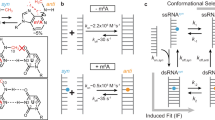Abstract
The quantum mechanical perturbation method has been utilized to study the biological activity of 8-azapurine (8-azaguanosine, 8-azaadenosine and 8-aza-2,6-diamino-purine) nucleoside antibiotics. The in-plane (hydrogen bonding) and stacking energy of 8-azapurine bases have been evaluated with nucleic acid bases and base pairs in all possible orientations. The energy values and the sites of association of analogous bases, obtained by optimization of energy values as well as the sites of association of nucleic acid bases during the transcription process have been compared. The model developed earlier for the incorporation of nucleoside analogues has been used to find out the inhibitory effects of the drug on nucleic acid and protein synthesis. It has been observed that the activity of 8-azapurines are of the following order
8-azaguanine > 8-aza-2,6-diaminopurine > 8-azaadenine
and these analogues show preference for binding near a guanine or cytosine in the chain. The results are in agreement with the experimental observations
Similar content being viewed by others
References
Caillet, J. and Claverie, P. (1975)Acta Crystallogr.,A31, 448.
Claverie, P. (1978) inIntermolecular interactions from diatomics to biopolymers (ed. B. Pullman) (New York: John Wiley) p. 69.
Grunberger, D., Holy, A. and Sorm, F. (1968)Biochim. Biophys. Acta,161, 147.
Grunberger, D. and Mandel, H. G. (1965)Mol. Pharmacol.,1, 157.
Grunberger, D., Maslove, R. N. and Sorm, F. (1964)Collect. Czech. Chem. Commun.,29, 152.
Lee, C-H., Evans, F. E. and Sarma, R. H. (1975)J. Biol. Chem.,250, 1290.
Levin, D. H. (1963)J. Biol. Chem.,238, 1098.
Levin, D. H. (1965)Biochem. Biophys. Res. Commun.,19, 645.
Levin, D. H. (1966)Biochemistry,5, 1618.
Ludemann, H. D., Westhof, E. and Cuno, I. (1976)Z. Naturforsch.,C31, 135.
Mandel, H. G. (1958)Arch. Biochem. Biophys.,76, 230.
Mandel, H. G., Carlo, P. E. and Smith, P. K. (1954)J. Biol. Chem.,206, 181.
Matthew, R. E. F. (1953)Nature (London),171, 1065.
Mitchell, J. H., Skipper, J. H. E. and Bennett, L. L. (1950)Cancer Res.,10, 647.
Montegomery, J. A. (1959)Cancer Res.,19, 337.
Montegomery, J. A., Johnston, T. P. and Shealey, Y. F. (1970)Med. Chem.,1, 680.
Nash, H. A. and Bradley, D. F. J. (1966)J. Chem. Phys.,45, 1380.
Ojha, R. P., Roychoudhury, M. and Sanyal, N. K. (1987)J. Biosci.,12, 311.
Ojha, R. P., Roychoudhury, M. and Sanyal, N. K. (1988)Indian J. Biochem. Biophys.,19, 237.
Otaka, E., Osawa, S. and Otaka, Y. (1961)J. Mol. Biol.,3, 393.
Pople, J. A. and Beveridge, D. L. (1970)Approximate molecular orbital theory (New York: McGraw-Hill).
Prusiner, P., Brennan, T. and Sundarlingam, M. (1973)Biochemistry,12, 1196.
Purnell, L. G. and Hodgson, D. J. (1976)Acta Crystallogr.,B32, 1450.
Roy, J. K., Kvam, D. C., Dahl, J. L. and Parks, J. R. E. (1961)J. Biol. Chem.,235, 1158.
Saenger, W. (1984)Principles of nucleic acid structure (New York: Springer-Verlag).
Sanyal, N. K., Kumar, U. and Roychoudhury, M. (1980a)Nucleic Acid Res.,8, 3975.
Sanyal, N. K., Kumar, U. and Roychoudhury, M. (1980b)Nucleic Acid Res.,8, 3983.
Sanyal, N. K., Roychoudhury, M. and Ojha, R. P. (1981a)Int. J. Quant. Chem.,20, 159.
Sanyal, N. K., Kumar, U. and Roychoudhury, M. (1981b)Int. J. Quant. Chem.,20, 179.
Sanyal, N. K., Roychoudhury, M. and Ojha, R. P. (1984)J. Theor. Biol.,110, 505.
Sanyal, N. K., Roychoudhury, M. and Tiwari, S. N. (1985a)Proc. Int. Symp. Biomol. Struct. Interactions, Suppl. J. Biosci.,8, 713.
Sanyal, N. K., Roychoudhury, M. and Ojha, R. P. (1985b)J. Theor. Biol.,116, 195.
Sanyal, N. K., Ojha, R. P. and Roychoudhury, M. (1986a)J. Comp. Chem.,7, 13.
Sanyal, N. K., Ojha, R. P. and Roychoudhury, M. (1986b)J. Comp. Chem.,7, 20.
Sanyal, N. K., Ojha, R. P. and Roychoudhury, M. (1986c)Int. J. Biol. Macromol.,8, 183.
Sanyal, N. K., Ojha, R. P. and Roychoudhury, M. (1987)Int. J. Biol. Macromol.,9, 19.
Saran, A., Mitra, C. and Pullman, B. (1978)Biochim. Biophys. Acta,517,255.
Shelley, Y. F. and Glayton, J. D. (1973)J. Pharm. Sci.,62, 858.
Singh, P. and Hodgson, D. J. (1974)J. Am. Chem. Soc.,96, 5276.
Singh, P. and Hodgson, D. J. (1975)Acta Crystallogr.,B31, 845.
Smith, J. D. and Matthew, R. E. F. (1957)Biochem. J.,66, 323.
Stent, G. S. (1971)Molecular Genetics (San Francisco: W. H. Freeman and Co.).
Vasanth Kumar, N. and Govil, G. (1982) inConformation in biology, (eds R. Shrinivasan and R. H. Sarma) (New York: Adenine Press).
Voet, D. and Rich, A. (1970)Prog. Nucleic Acids Res. Mol. Biol.,12, 183.
Watson, J. D. (1970)Molecular biology of the gene (California: W. A. Benjamin Inc.).
Weinstein, I. B. and Grunberger, D. (1965)Biochem. Biophys. Res. Commun.,19, 647.
Author information
Authors and Affiliations
Rights and permissions
About this article
Cite this article
Ojha, R.P., Sanyal, N.K. Molecular basis of activity of 8-azapurines in transcription processes. J Biosci 14, 319–328 (1989). https://doi.org/10.1007/BF02716693
Issue Date:
DOI: https://doi.org/10.1007/BF02716693




